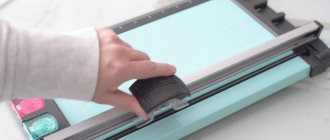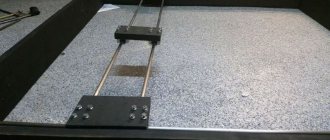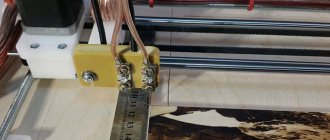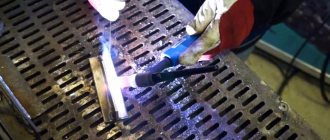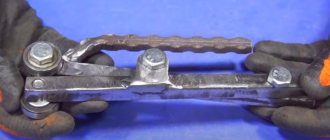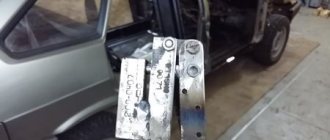Attachment for shape cutting of thin sheet steel
Step one. The basis
First of all, we will make the base of the nozzle, on which all other components will be located. First, you will need a piece of round pipe; the diameter should be such that the pipe fits tightly onto the part of the grinder where the shield is attached. You can make a clamp from a pipe, or you can simply shrink it to the desired diameter by cutting and welding.
Next, we weld a piece of a square pipe well to the round pipe, everything should be welded as tightly as possible. To screw the base to the grinder, we make steel plates, these ears are screwed to the grinder with bolts, and the ears are welded to the base.
Step two. Stock
We make a rod that will perform reciprocating movements. The rod is made of a steel plate; you need to cut an oval hole in it for the angle grinder shaft. The rod is driven by a radial bearing, which is offset on the angle grinder shaft.
The guides for the rod are slots cut in a square pipe that is welded into the base. Stops are welded to the rod, and it is against these stops that the radial bearing rests.
Step three. Guide
We make a guide for the working body (a piece of the valve), it will not allow the working rod to move left or right. The author formed the required groove from steel plates; everything is done by cutting and welding. Finally, after grinding on a sharpening machine, the entire product looks like a solid and reliable design.
Drive disassembly
Having the drive in front of you, first remove the top cover by unscrewing 4 screws. Then the movable mechanism, which is located in the center and connected to the printed circuit board with a flexible cable, is removed. The next goal is a laser diode, securely pressed into a radiator made of aluminum or duralumin alloy. It is recommended to provide protection against static electricity before dismantling it. To do this, the leads of the laser diode are soldered or wrapped with thin copper wire.
Next, there are two possible options. The first involves operating a finished laser in the form of a stationary installation together with a standard radiator. The second option is to assemble the device in the body of a portable flashlight or laser pointer. In this case, you will have to apply force to cut through or saw the radiator without damaging the radiating element.
Tools and methods for cutting metal
Metal scissors are also effective for cutting. Depending on the type and thickness of the material, the following types of tools are distinguished:
- ordinary hand scissors (used for sheet steel with a thickness of 0.4 - 1.1 mm);
- chair scissors (they have large dimensions and are suitable for steel up to 2.5 mm);
- power shears (for steel up to 5.0 mm);
- lever or swing shears (for long material with a thickness of up to 3.0 mm);
- guillotine (have inclined knives, suitable for thick steels up to 32 mm).
Mechanical methods of cutting metal
For mechanical cutting of workpieces, tools made of special hardened steel are used - this guarantees their strength and ability to cut through metal. Cutting is carried out using a guillotine, band saw or circular saw.
- Cutting metal using a guillotine.
Guillotine processing is most often used in stamping operations when it is necessary to produce a large number of standard products. The rolled sheet is laid on a horizontal working surface, and a special cutter cuts it across its entire width. It is noteworthy that this cutting method is somewhat reminiscent of scissors - the contact of the knife and the workpiece occurs at an angle at one point, which moves as it moves.
- Cutting metal with a band saw.
This processing of metal workpieces is very similar to the method of cutting metal without electricity - with a classic saw. Only in this case is the metal blade with teeth fixed on pulleys, which ensure its continuous movement. This method cannot be called waste-free, because the width of the cutting mechanism is 1.5 mm, which causes chips to form. It is worth noting that such units can cut not only flat sheets, but also pipes of any diameter.
- Cutting metal using a disk machine.
The tool for work is a cutting disc with teeth along the outer contour. It is driven by an electric motor, and a protective casing protects the worker from work-related injuries. A disc saw is a lot like a pipe cutter. The edges on it are of high quality and the cut is precise. The latter can be done at an angle if necessary.
Electric metal shears
An excellent metal cutting effect is achieved using electric scissors. There are more than 10 varieties of this tool, but they are united by the ability to cope with almost any material, as well as the ability to carry out shape cutting. Electric metal shears can be considered a specialized tool for these purposes.
Thus, there are a lot of devices that can cope with the task in question. Which device to choose depends on the frequency with which you have to cut metal, the thickness of the material and your budget.
Using different saws
Band saws and circular saws are suitable for cutting aluminum. Advantages of the first:
- small cutting width;
- possibility of angular processing;
- compactness.
The design of modern devices includes useful devices, including a rotating saw frame, a thread (band) tension meter, a variator for smoothly changing cutting speeds, and a built-in saw blade cleaning system. The quality of the equipment is comparable to laser and plasma, only the master will save a lot (on money, work time and space).
The second type of saw used when cutting aluminum is a circular saw. They are divided into frontal and die-cutting, can look like a floor-standing or table-top machine, and have one or two working heads. Devices in the mid-price range have clamps for fixing the workpiece at an angle. The active element - a disk with a diameter of up to 550 mm - must have diamond coating on the teeth and indicate that it is suitable for cutting aluminum.
Advantages of working with circular saws:
- modern installations guarantee operator safety during operation;
- automatic cutting possible;
- smooth feeding of the cutting element;
- availability of waste compartments.
Disc material - high-speed steel (HSS marked). Some installations allow the workpiece to be rotated at an angle of up to 45 degrees for ease of operation.
Making your own laser for cutting metal - instructions and recommendations
Today anyone can make a laser for cutting metal with their own hands. And this fact cannot but rejoice, because a cutter is a unique device with which, without much difficulty, you can qualitatively and accurately cut metal of almost any thickness.
Advantages of laser cutting
The demand for this method of processing materials is determined by several factors.
Cutting quality
The first and one of the most significant indicators is the high quality of laser-cut products. Such parts have a smooth, even cut and are characterized by the absence of any flaws on the treated surface.
Versatility of the method
The second important advantage of laser cutting is that with the help of this procedure it has become possible to process almost all types of products, regardless of the hardness of the alloy from which they are made, their thickness or shape. In addition, the laser method of cutting parts is not limited to cutting in a plane, that is, it is possible to cut three-dimensional objects.
Possibility of process automation
The third advantage is the ability to automate the process of cutting metal with a laser using computer equipment. This property allows you to save not only time, but also money on the manufacture of special casting molds necessary for the production of products. This improves the productivity of the installation.
Computer-controlled metal cutting produces higher-quality parts that do not require additional turning and grinding.
Note that all of the above qualities are inherent, to one degree or another, in all metal laser cutters, both industrial and homemade. The only difference between them lies in the power of these devices. Thus, hand-made lasers for cutting metal have less power compared to professional laser machines. They are great for cutting plywood and thin sheets of metal, but are not able to handle super hard and thick metal products, unlike specialized equipment.
Protecting the fiber laser from reflected beams
It is important to understand that certain metals pose a certain danger to the laser with which they are processed. This is due to their characteristic significant reflection coefficients.
The advantage of IPG products is that they are designed to protect fiber emitters from reflected rays.
Lasers of this brand are offered in two protection options:
- LK - have a passive system, the sensors of which catch reflections and inform the operator about the identified danger;
- LS is an active system. Allows you to level out identified dangerous reflections. You don't have to interrupt your work for this.
Machines of the second type are the best solution for processing workpieces made of materials such as aluminum, brass, mirror stainless steel, and copper.
Another indisputable advantage of IPG products is a better Gaussian beam, which provides a more stable cut. However, this does not affect the thickness of the workpieces being cut and the cutting speed.
Homemade 5500mW laser wood burner
What characteristics should a CNC burner have, how do the products differ, and is it possible to design them yourself? Experts warn that before you go to the store to buy a device or try to assemble it, you need to understand the mechanism of operation of the CNC machine and think about which control program will be optimal.
Recently, pyrography has been developing and gaining particular demand; people order wood-burned paintings and portraits from professionals as souvenirs and gifts. Therefore, experienced craftsmen and lovers of this activity had the idea of opening their own small business based on burning images.
Processing of the finished product
The finished painting is either left uncoated or treated with one of the following options:
- Clear varnish;
- Furniture wax;
- Wood oil.
The plaque can also be framed in a beautiful frame. Wooden frames look better on a wooden background. You should not use thin plastic frames for diplomas and letters of gratitude. Plastic frames do not always look organic with natural wood.
During the low season (falls during vacations and vacations), to stimulate sales, you can announce a “free frame” or “larger size at a lower price” promotion. This way you can maintain the price of goods in the portrait burning business, without practically increasing your costs. This approach is preferable to deep discounts.
Remember: people don't know exactly how burning occurs. Especially if you make a portrait with the effect of a pencil drawing, it will be difficult to distinguish it from the artist’s work. A complex and labor-intensive (in the client’s understanding) task cannot be cheap, which completely devalues the work of the master.
Disassembling the DVD-RW drive
This process must be done with great care, since the internal parts are fragile and can be easily damaged. Having dismantled the case, you will immediately notice the necessary part; it looks like a small piece of glass located inside the mobile carriage. Its base needs to be removed; it is shown in Fig. 1. This element contains an optical lens and two diodes.
At this stage, you should immediately warn that the laser beam is extremely dangerous to human vision.
If it hits the lens directly, it damages the nerve endings and the person may remain blind.
The laser beam is blinding even at a distance of 100 m, so it is important to watch where you point it. Remember that you are responsible for the health of others while such a device is in your hands!
Figure 3. LM-317 chip.
Before you begin, you need to know that the laser diode can be damaged not only by careless handling, but also by voltage surges.
This can happen in a matter of seconds, which is why diodes operate based on a constant source of electricity. When the voltage increases, the LED in the device exceeds its brightness standard, as a result of which the resonator is destroyed.
Thus, the diode loses its ability to heat, it becomes an ordinary flashlight.
The crystal is also affected by the temperature around it; as it drops, the laser performance increases at a constant voltage. If it exceeds the standard norm, the resonator is destroyed according to a similar principle. Less commonly, the diode is damaged by sudden changes, which are caused by frequent switching on and off of the device over a short period.
After removing the crystal, you must immediately tie up its ends with exposed wires. This is necessary to create a connection between its voltage outputs.
To these outputs you need to solder a small capacitor of 0.1 µF with negative polarity and 100 µF with positive polarity. After this procedure, you can remove the wound wires.
This will help protect the laser diode from transients and static electricity.
Choose and use a laser engraver
And this is a homemade engraver, but more on that later.
Currently, there are many well-known brands that supply laser engravers. The device is almost the same everywhere, but many of them differ in their factory configuration and functionality. First of all, when choosing a laser engraver, you need to clearly define the purpose of its use, as well as what points you need to pay attention to when drawing up an estimate and not miss anything.
Electrical circuit design
When assembling a homemade burner, you must have knowledge in the field of radio electronics. This will allow you to develop an electrical circuit. If you do not have skills in this area, you can use the diagram presented below.
The circuit can be simple or quite complex, tailored to the developer’s requirements. The task is to select the most acceptable option and implement it in practice.
